What Is a Tuna Can Size and Why Does It Matter
Tuna can size describes the net weight on the outside, but that number doesn’t always match what you eat. A 5 oz can can end up giving you only 3–3.5 oz of fish after you drain off the liquid. That little gap matters when you’re sticking to a recipe or controlling portions, especially if you’re tracking how much protein you take in each day.
The variety of can sizes is useful for different purposes: a small tin is good to use with snacks or when you want to have a single portion, whereas a larger can is convenient to use with the family meal or when you cook in large quantities. Portion and nutrition are also influenced by types of tuna such as skipjack, yellowfin, or wild pink salmon.
Knowledge of size of canned tuna prevents wastage, makes the recipe better, and also aids smarter shopping based on cost, pack design, and sustainability. No matter whether you want chunk light tuna on a sandwich or solid white albacore in a casserole, size matters more than you may imagine.
Tuna Can Size Chart: From Single-Serve to Family-Size
In terms of the sizes of canned tuna, you should use the size that suits your purpose, whether you are cooking alone or serving a large number of people. To help you know which size of canned tuna to use, here are the most typical canned tuna sizes and their usage.
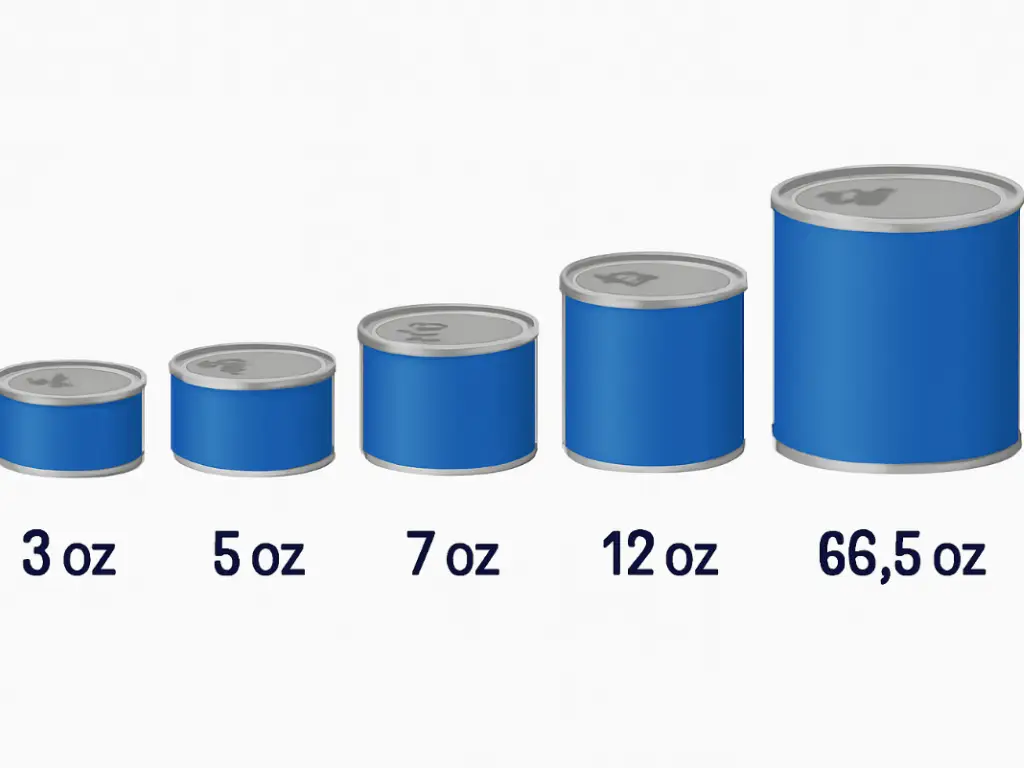
- 3 oz
The 3 ounce can is made for those quick bites when you want just the right amount of chunk light tuna. With 90 to 110 calories, depending on the liquid, it fits right into low-carb and keto plans. You can dump it straight onto greens, mash it with avocado, or just grab a fork and dig in.
- 5 oz
The 5 ounce can is the everyday size. It shows up in lunches, mixed into pasta, or piled on a salad with a splash of dressing. You’ll drain it down to about 3.5 ounces of tuna, landing in the 100 to 120 calorie range. You can choose chunk light or albacore, and it’s plenty for a single hearty meal.
- 7 oz
7 oz cans are just a little bigger, ideal when two people are sharing or when you want a bit more than the standard serving size. They typically include solid or flaked white albacore tuna, which is perfect in wraps or sushi bowls or as a baked potato topper. You’ll see 130 to 150 calories in a single serving, depending on the brand.
- 12 oz
The 12 oz can is designed for family-sized meals or recipes. It can be big tuna salad or casserole. This size saves time, and not that many cans need to be opened. Filled with chunk white albacore or wild pink salmon, it contains 220-250 calories a serving. Ideal to cook in large quantities.
- 66.5 oz
The 66.5 oz can is used in large-scale activities such as catering, schools, or restaurants. The size is mostly employed in bulk salads or sandwich spreads and carries chunk light tuna or solid white albacore. Its drained weight is about 50 oz, which makes it perfect to do high-volume cooking. It is also a green alternative, reducing packaging waste.
Understanding the different types of tuna and how they are packaged will help you choose the right size can. For more information, please refer to our guide to different types of canned tuna.
Net Weight vs. Drained Weight: What’s the Difference?
When you check the sizes on canned tuna, it pays to know the difference between net weight and drained weight. Net weight is the complete mass of what’s inside the can, including the fish and the liquid, usually water or oil. That’s the number you see on the front, like 5 oz or 142 g.
Drained weight tells you how much tuna is left after you pour off the liquid. For the common 5 oz can, you’ll usually get around 3 to 3.5 oz of fish ready to eat. That gap is key if you’re following a recipe, counting calories, or working out how much protein you eat each day.
When drained, tuna in oil tends to lose less weight compared to tuna in water. Also, solid white albacore tuna is more prone to retain mass compared to chunk light tuna, which is more shredded and soft.
Some brands, like Starkist and Clover Leaf, print both weights on the label. That extra number is handy because it helps you stick to nutrition advice, especially if you’re monitoring sodium, fat, or daily value limits. Understanding the difference keeps your cooking and nutrition tracking on point.

Chunk Light, Solid White, and Flake: How Tuna Type Affects Can Size
When it comes to the size of the canned tuna, the weight is also important insofar as the type of tuna is concerned. Be it chunk light, solid white, or flaked tuna, they all have their peculiarities, which influence the portion sizes, texture, and culinary application.
- Chunk Light Tuna: When tuna is packed, the can undergoes sterilization that subjects it to hot, steam-purged conditions. The lower profile and greater diameter help the can distribute internal pressure more uniformly, minimizing the chances of weak spots that could bend or bulge.
- Solid White Albacore Tuna: This tuna is derived from the larger albacore tuna and is more firm and light in color, and comes in solid chunks. It is usually sold in 5 oz, 7 oz or 12 oz cans and has less liquid. The solid white tuna is more rigid, and it is suitable to use when the tuna is the primary component of the dish, such as sushi bowls or toast.
- Flaked Tuna: Flaked tuna is usually light tuna, which is shredded into very small pieces, commonly found in large-volume packs to be used in mass cooking, such as a cafeteria or catering. This kind is largely found in 12 oz or even 66.5 oz foodservice cans. It is good on tuna casseroles or on mixed tuna salads.
The texture of tuna is a determining factor in how it is packed and the size of the cans. Firmer cuts of white albacore tuna, which are large chunks of tuna, are usually tightly packed because they retain their shape better. This usually leads to a more compact and shorter can design. Chunk light tuna, on the other hand, is softer and shredded and is therefore packed in large quantities; and therefore it is more often available in small and cheaper quantities. This variation in packing affects the design of the pack, as well as the control of portions.
Nutritionally, tuna is a great source of lean protein across the board, but there are a couple of differences. Chunk light tuna typically comes with lower mercury concentration, which is why it’s the better choice for those who like to make tuna a regular part of their meals. Solid white albacore, while also a solid protein source, carries a bit more mercury, so if you’re planning to have tuna consistently, it’s smart to keep that in mind when you’re deciding which type to pick for the week.
Why Are Tuna Cans Short and Wide? A Curious Look Into Can Design
Have you ever noticed how tuna cans differ from the tall, slender shapes of soup or vegetable cans? They’re typically short, wide, and relatively flat, and every aspect of that form is deliberate. Let’s dive into the why behind the shape.
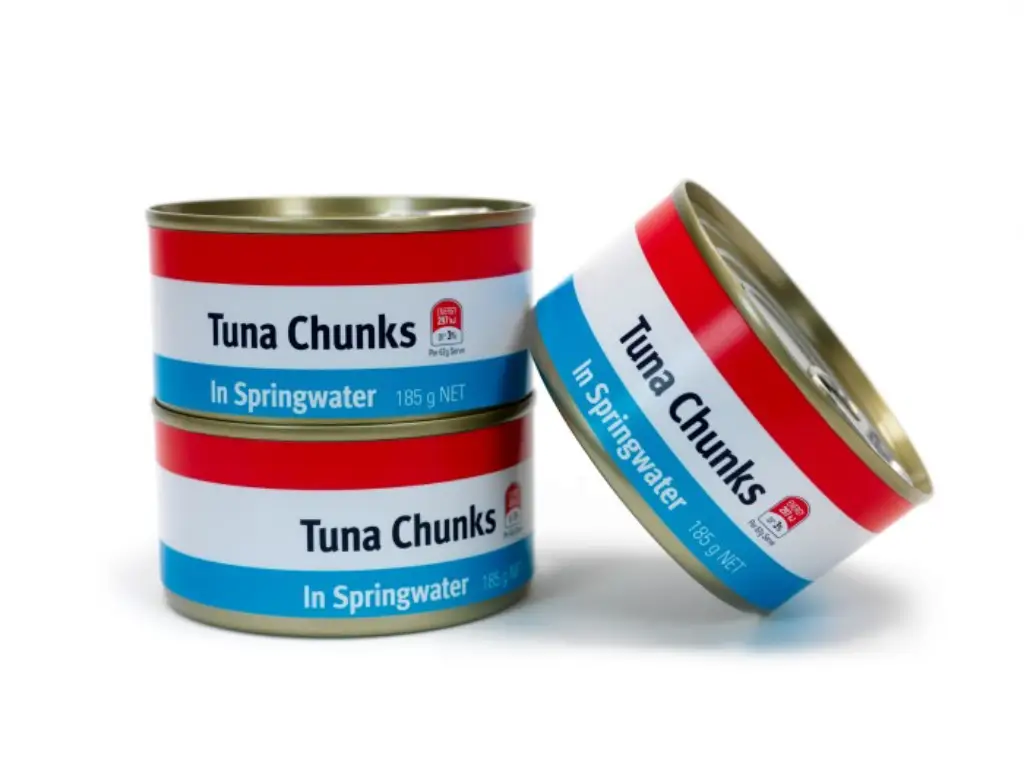
- Packaging Science & Pressure Distribution: The low and wide design enables better pressure distribution in the canning process, which is usually done at high heat and vacuum packaging. This minimizes the chances of bulging or collapsing.
- Stackability & Storage Efficiency: Short flat cans can be stacked more safely both in storage in the factory and storage at home in the pantry. These also occupy less space vertically, and that is ideal in shipping and shelving displays.
- Consumer Convenience: The opening is broader, which facilitates accessing the tuna with a fork or a spoon and increases the convenience of draining fluid. It is just more convenient to the user as compared to tall, narrow cans.
- Branding, Tradition, and Cost Optimization: StarKist and Bumble Bee are brands that have standardized this type of form factor over the decades. Since the manufacturing systems changed according to these dimensions, alteration would now be costly in production. The current design is also a tradeoff between the aesthetic, practical, and economic.
Fun fact: Some gourmet tuna brands in Europe and Asia use square or oval cans to stand out, but they still face challenges in mass retail shelving systems designed for round formats.
Tuna Can Sizes Around the World: US vs. Europe vs. Asia
Tuna is a staple of the pantry in every country worldwide, but it is packed and sized very differently based on location. These differences are influenced by regional food preferences, food packaging standards, and cuisine. The following is a real-life example of the most common tuna can sizes in the United States, Europe, and Asia, together with their favorite units of measurement and the packaging models used.
United States: Ounce-Based Standardization
The size of canned tuna in the U.S is usually in ounces (oz). The can that is most popular and widely available is the 5 oz (142g) can- it is the industry standard size of lunch preparation, recipes, and single-meal servings. This is normally 3.5 oz (99g) of edible tuna after draining.
Other popular sizes in the U.S. include:
| Net Weight | Use Case | Notes |
| 3 oz / 85g | Snack-size / single serving | Often sold in peel-top pouches |
| 5 oz / 142g | Standard size | Most recipes refer to this size |
| 7 oz / 198g | Large single meal / shared | Less common, found in club stores |
| 12 oz / 340g | Family meals/meal prep | Ideal for casseroles and bulk use |
| 66.5 oz / 1.88 kg | Commercial use | Found in foodservice kitchens |
The American packaging trend is inclined to short and wide cylindrical cans. Water-packed tuna is more prevalent than oiled, and albacore tuna (sold under the label solid white) is sold as a higher-quality product.
Europe: Compact and Oil-Focused
European consumers tend to have a preference for smaller can sizes with metric weights being common, i.e., 80g, 90g, 120g, and 160g. However, in Europe, tuna is used as an addition to salads or appetizers or tapas, so it does not need large amounts like it does in the U.S.
| Net Weight | Common Use | Notes |
| 80g – 90g | Light meal topping | Often found in flat, oval tins |
| 120g – 150g | Versatile meal prep | Olive oil-packing is common |
| 185g | Multi-portion / shared dish | Used in pasta or rice dishes |
Cans are also flatter and oval-shaped to allow convenient stacking and appearance. Tuna in extra virgin olive oil is very common and it is an expression of regional culture, gourmet and cuisine, especially in Mediterranean regions such as Italy, Spain, and France.
There is a high concern for sustainability in Europe, and a large number of brands are labeled MSC (Marine Stewardship Council) or Dolphin Safe.
Asia: Variety and Functionality
Tuna can sizes in Asian markets are not standardized and range between 70g to 185g, depending on the intended use, e.g., rice dishes, lunchboxes, or instant meals. The packaging is characteristically brightly graphically designed, has bilingual labels, and an extensive variety of flavors, such as soy sauce, chili oil, and vegetable mix-ins.
| Net Weight | Region | Typical Use |
| 70g – 100g | Japan / Korea | Bento, rice topping, snacks |
| 150g – 155g | Thailand / Vietnam | Stir-fries, family-style meals |
| 185g | Philippines | Sandwiches, rice dishes |
Skipjack tuna is the most prevalent one in Asia, with a mild flavor and soft texture. Light tuna, usually flaked or chunky, fills most products that are either packed in brine or vegetable oil. Value-added tuna, such as curry-flavored or yuzu-seasoned tuna, is common in convenience stores in Japan.
Adapting to Every Can Size and Shape
Having been filled with the world of varieties of tuna can size, the preferences of different markets, and the rationale behind the shape of the can, it is but natural to ask the question: How can food producers pack all these variations efficiently?
The solution is not a universal “one-size-fits-all” machine, but a very flexible and exact packaging technology. Be it diameter, height, or shape, each can dimension needs precisely adjusted instruments that will provide efficient, safe, and hermetic sealing.
This is where the experience of Levapack comes in.
Levapack, being a manufacturer of food packaging machinery, has more than 18 years of experience in the industry to offer completely automated systems, including filling and sealing, as well as labeling. Our machines are designed to fit all needs, whether it is the 3 oz can on the pocket size or the 66.5 oz foodservice tin.
The key strengths in Levapack are:
- High Customization Capabilities: OEM /ODM, equipment that can be used with a variety of materials, sealing types, and can be designed, and fast turnaround of design draft, which can be completed in 1-2 days.
- Precision Manufacturing: The factory is also furnished with CNC machining tools, which ensure that the part tolerance is at 2mm or less, which guarantees high seal integrity and durability.
- Rapid Delivery: Standard models would also be fast-delivered, and the customer can get the equipment he/she need almost right away. The time of custom equipment delivery can be changed depending on project needs.
- Global Service Support: Our distributors in strategic locations such as North America, Europe, the Middle East, and Southeast Asia provide after-sales services and remote debugging services.
We know that variations in tuna can sizes and shapes are based on the demands of various markets and the needs of consumers. Being flexible, filling and sealing solutions, the products by Levapack can help food brands quickly respond to the trends in the market, enlarge production lines, and enhance brand competitiveness.
If you are interested in packaging equipment for tuna cans, you can learn about our tuna can sealing machine, which ensures the cans are sealed and prevents leakage.

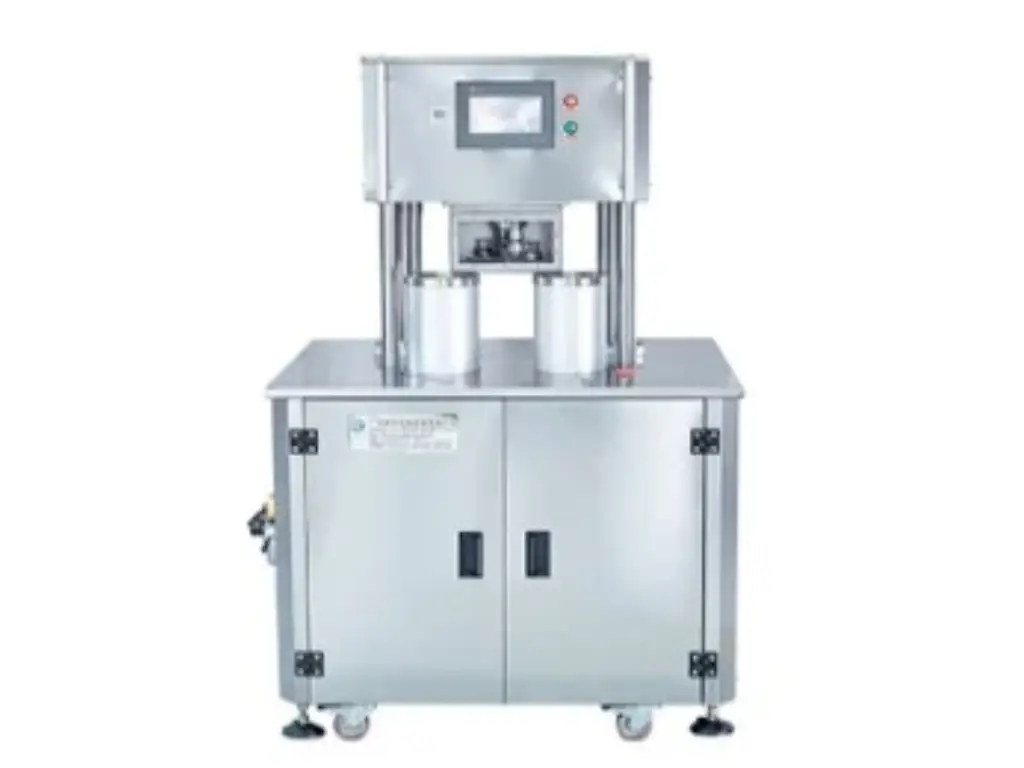
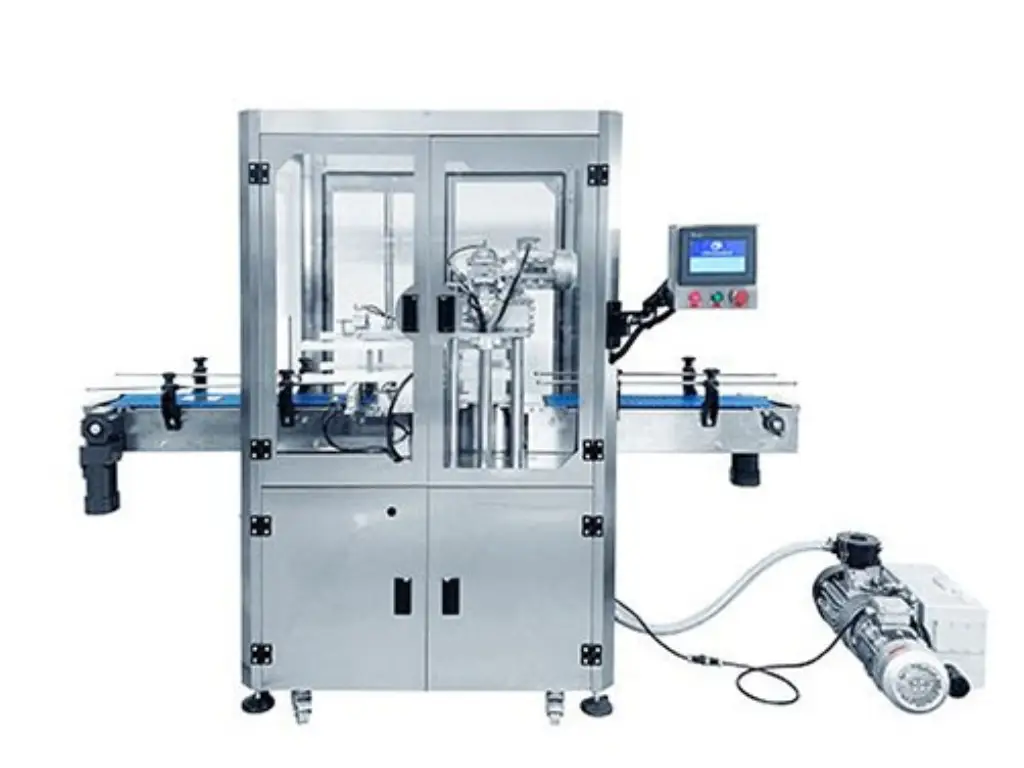
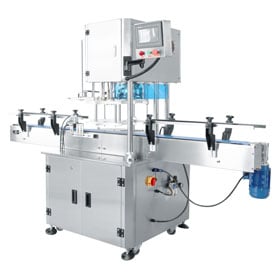


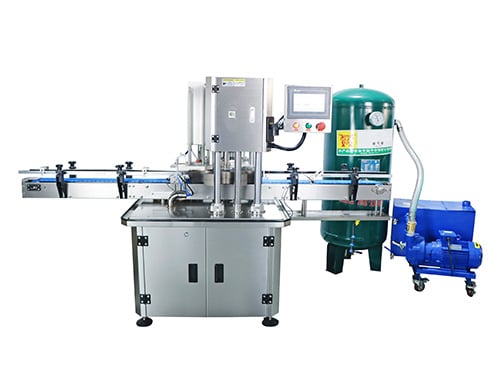




Final Thoughts
Knowing the sizes of canned tuna is not only a matter of pulling a can off the shelf; it is also about making more intelligent choices about what you put on your plate, about getting your servings right, and using the right kind of product at the right time. When you pick up a 3 oz single-serve, a 12 oz family can, or a 66.5 oz foodservice tin, each size, each style can have a purpose. Therefore, next time when you pick up a can, just think twice, thinking beyond the label. It is not only tuna inside.




